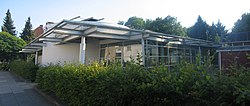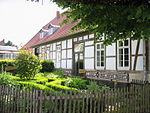Doberg Museum
 Entrance area shortly before the partial demolition in the course of the renovation |
|
| Data | |
|---|---|
| place | Frets |
| Art | |
| architect |
Dieter Quiram (new building) Andreas Krys and Katja Flörke (renovation and conversion) |
| opening | May 9, 1937 |
| management | |
| Website | |
| ISIL | DE-MUS-791419 |
The Dobergmuseum - Geological Museum Ostwestfalen-Lippe is a geological museum in the East Westphalian town of Bünde . The collection mainly includes fossil finds from nearby Doberg . The Doberg Museum is part of the Bünde Museum .
exhibition
The Doberg Museum mainly shows finds from the Doberg , a fossil deposit from the Oligocene that belongs to the city . The Doberg represents one of the most extensive fossil deposits from the time of the Oligocene north of the Alps and is considered a stratotype for this epoch. It consists of the sediments of the Oligocene Sea and provides information about the marine fauna of that time. Nowhere else in the world, as far as we know today, are the strata of the Oligocene so complete and well preserved as here.
The most famous object is the fossilized skeleton of a manatee . In addition, fossilized prints of the fauna and flora of that time are exhibited, including parts of a toothed whale . A cast of dinosaur tracks from the Lower Cretaceous can be viewed in the museum garden . The original in Obernkirchen sandstone will in future be part of the exhibition in the Doberg Museum. The dinosaur tracks of Barkhausen can be viewed at the original site not far from Bündes .
history
The museum is largely based on the collection of the Bünder teacher Friedrich Langewiesche , who began excavations in Doberg in 1907. First he exhibited his collection in the Bünder Realprogymnasium . In 1912 the manatee was found in Doberg, which is still the most important exhibit in the museum today. In 1927 Langewiesche, meanwhile appointed professor in recognition of his research in the region, bequeathed his collection to the city of Bünde. In 1937 the city of Bünde transferred the exhibits to the Herford district , which among other things set up a district museum in Bünde with these archaeological exhibits. This museum was housed in the half-timbered building (Striedieckscher Hof) next to today's Doberg Museum. Langewiesche became the first director of the museum financed by the district. Until 1999, the German Tobacco and Cigar Museum , the exhibition on local history and the exhibition about the finds in Doberg shared the Streidieckschen Hof. In 1999, with the help of the NRW Foundation and other sponsors, today's Doberg Museum was built as a new building. As serious construction defects were discovered shortly after the opening, the museum was closed in 2009 for a thorough renovation and reopened on December 22, 2011.
Location
The museum is located on the so-called Museum Island, an ensemble of several half-timbered houses and the Doberg Museum, which was newly built in 1999. All museums housed on Museum Island are part of the Museum Bünde network , which also includes the District Home Museum and the German Tobacco and Cigar Museum .
gallery
Lower jaw piece of a Squalodon sp. (Toothed whale), found in Doberg, today in the Museum für Naturkunde (Berlin) .
Striedieckscher Hof - today the location of the German Tobacco and Cigar Museum . The exhibits from Doberg were exhibited here between 1937 and 1999
See also
Individual evidence
Web links
- Dobergmuseum - Geological Museum Ostwestfalen-Lippe eV
- NRW Foundation: Doberg Museum. The swimming cows of Westphalia.
- Virtual tour of the Doberg Museum
Coordinates: 52 ° 11 ′ 42.7 " N , 8 ° 34 ′ 55" E


